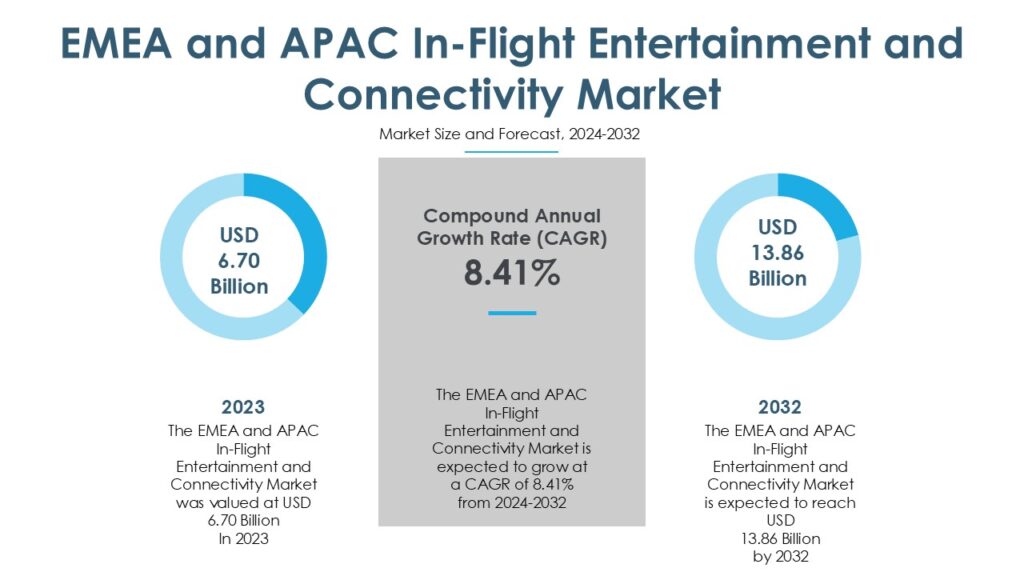In-flight entertainment is an airline-provided service that has provided movies, music, newspapers, and magazines for a long time to ensure that long-term on-board passengers are comfortable and not bored. The airline industry has recognized that in-flight entertainment is one of the most important passenger selection criteria while booking travel on a particular airline.
The aviation industry is recently creating new added value by improving customer service through smart cabins using information and communication technology. The market for in-flight wireless fidelity services continues to grow with the development of wireless local area network transmission technology, deregulation of the use of electronic devices in aircraft, and increasing customer demand to use the internet regardless of location. As technology has progressed dramatically, more airlines are adding features to the in-flight entertainment system to send and receive emails, surf on the internet, and stream content directly on the passenger’s electronic device via wireless setup.
The EMEA and APAC In-Flight Entertainment and Connectivity Market was valued at US$ 6.70 Billion in 2023 and is anticipated to reach US$ 11.86 Billion by the end of 2032 with a CAGR of 8.41% from 2024 to 2032.

The basic idea behind the in-flight entertainment system was to provide passengers with comfort during their long-range flights, so services were initially based on delivering food and drink to passengers, as passengers’ demand for more service grows, accompanied by an increase in airline competition and technology advancement, more services were introduced and modern electronics device played a remarkable role. This caused a change in the basic concept behind in-flight entertainment and connectivity. It becomes more than just giving physical comfort. It is extended to provide interactive services that allow passengers to participate as a part of the entertainment process as well as providing business-oriented services through connectivity tools.
Factors Driving the Growth of the EMEA and APAC In-Flight Entertainment and Connectivity Market in EMEA and APAC:
EMEA and APAC are the largest markets for In-Flight entertainment and connectivity. Increase in the advancement of technology such as high speed of internet technology and other advanced services. increasing urbanization and increased population also the increased incomes of people the more growth to in-flight entertainment and connectivity.
With the increase in advancement, the customers’ expectations also increase about the quality and in-flight entertainment services and connectivity. In the Asia Pacific region the more growth in aviation technologies in the different countries of Asia such as India, China, etc.
In the region increasing competition between airline companies, everyone tries to provide the best in-flight entertainment and services for their customers. Increasing new generations such as youth giving more preference to the best quality of entertainment services.
In the APAC and EMEA regions more growth for tourists as according to their demand the best in-flight entertainment services are provided by the airlines. The enhancement of 5G technology and the satellites boost the growth of the market.
The government in the region provides investments for in-flight entertainment and connectivity. Modernization of airline services in the regions increases the growth of the market.
Competitive Insights:
Some of the key players of the EMEA and APAC In-Flight Entertainment and Connectivity Market are as follows: Iridium Communications Inc., Anuvu, EchoStar Corporation, Honeywell International Inc., Intelsat, Kymeta Corporation, SITA, Panasonic Corporation, Thales Group, Thinkom Solution, Kacific, Astro Malaysia, SpaceX, CurvaNet, Bae System, Cobham Plc., Collins Aerospace, Eutelsat Communications, Global Eagle Entertainment Inc., Gogo LLC, and Inmarsat Plc.
Prominent players like Iridium Communication, Anuvu, Ecostar Corporation, and Honeywell International Inc. dominate the EMEA and APAC In-Flight Entertainment and Connectivity Market. These companies invest heavily in research and development and widen their product portfolios to increase their market share.
Kymeta Corporation continues to be a dominant force in the EMEA and APAC In-Flight Entertainment and Connectivity market, leveraging its extensive global presence and diverse product offerings. SITA maintains a strong competitive position, providing innovative solutions for various facilities of aviation in the industry.
For companies like Gogo LLC, in-flight connectivity is no longer a luxury, it is a necessity. Gogo Avance benefits passengers, pilots, and operators alike. They have created a platform that is completely unified, scalable, and designed to be sustainable not replaced. Gogo Avance provides a complete digital engine that drives it all, internet, voice, entertainment, cockpit apps, plus self-service tools, and remote support.
Sustainable solutions have become a key competitive factor. Companies like Eutelsat Communication, and Global Eagle emphasize environmentally friendly practices, responding to the increasing consumer and industry focus on sustainability.
The competitive landscape is shaped by companies adapting to market trends, such as the rising consumer demand for products, convenience, and the reduction of environmental impact through sustainable aviation solutions.
Adherence to stringent quality and safety standards and compliance with evolving regulations are crucial for maintaining a competitive edge in the EMEA and APAC In-Flight Entertainment and Connectivity Market.



